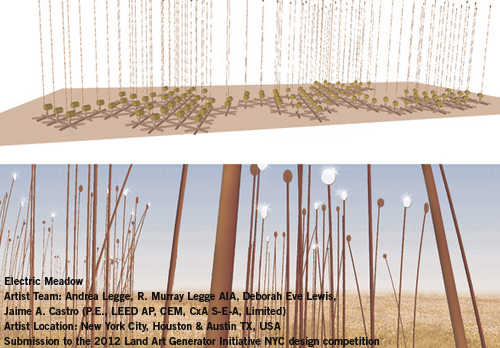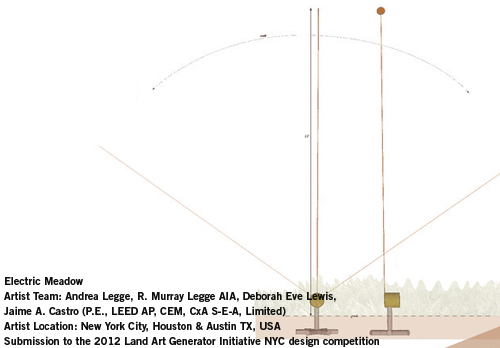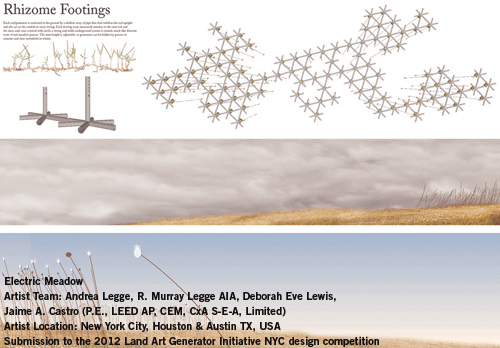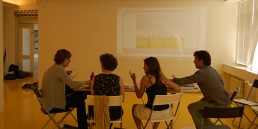Electric Meadow
Submission to the 2012 Land Art Generator Initiative NYC design competition
Artist Team: Andrea Legge, R. Murray Legge AIA, Deborah Eve Lewis, Jaime A. Castro (P.E., LEED AP, CEM, CxA S-E-A, Limited)
Artist Location: New York City, Houston & Austin TX, USA

Artist Descriptive Text:
Electric Meadow is a safe, scalable kinetic sculpture that is sited within a tall wild meadow, such as the Dry and Moist Prairies proposed in the Fresh Kills Park draft master plan. There are areas of both of these landscapes proposed within the boundaries of the LAGI Fresh Kills competition site. An array of tall, thin steel rods sway in the breeze, anchored at their bases through low cylindrical metal housings hidden by tall meadow grasses. Within the rugged housings are simple generators that make use of the movement of the rods as they sway in the wind. A sensitive pivot-return spring mechanism, along with the tensile qualities of the rods themselves, ensures a sustained, pendulum-like movement once activated. The rod/generators would be sited and oriented to make the most use of prevailing winds at the site. At the tops of the rods are small steel shapes designed to catch the wind. (Further developments for the tops could include 3-dimensional housings for micro generators that use wave-motion technology to generate small amounts of electricity. Also, developing the rod itself from piezoelectric materials may be considered.) The rods will mimic the movements of natural tall grasses, animated by wind, birds and people.

The general design of Electric Meadow is vastly scalable in both height and number of rods, able to accommodate a variety of contingencies with regard to topsoil thickness, siting, budgets, proximity of other park amenities, etc.. The array can be evenly or randomly spaced, and rods can be placed at varying widths apart from one another. The project could appear as a dense random ‘mutant meadow’, or as a more ordered array of analogous kinetic sculptures. The project can be sited all in one area or in smaller patches throughout the competition site, perhaps placed near to trail lighting which it could power. Electric Meadow can be placed on a slope. The footing stems can be modified to keep rods plumb. The length of the ‘stem’, which attaches the generator to the footing, is adjustable, so that generator cylinders clear snow drifts in winter and are hidden by grasses in summer. Units can be arrayed in such a way as to create trails through them, providing access so visitors can sway the rods and create power themselves. Or the project can be sited in more wild habitats, as described in the Environmental Impact paragraph. Electric Meadow is quiet except for the breeze sounding through the rods, and largely unobtrusive.

Generator, Electrical System Overview & Power Generation
The electrical system for Electric Meadow consists of a typical renewable power system that will resemble a wind and solar system configuration. The system will consist of direct current (DC) wiring connected to each small-scale generator. A group of individual units connected together will form one circuit known as a ‘string’. The strings are then collected at a DC Combiner box that acts as an electrical panelboard for each individual circuit and protects each circuit with a fuse. The box also has a main disconnect switch. These protection devices are required by the National Electric Code 2011 Article 694: Small Wind Systems. From the combiner boxes, the power then is connected to a DC to AC Power Inverter which converts the Electric Meadow-generated power to a usable form. This power is then connected to electric loads such as park lighting, kiosks, or can be used to charge a battery bank for stored power. Small combiner boxes can be placed unobtrusively at the head of each string, hidden by tall grasses.
Electric Meadow is easily scaled. It can consist of a few, or several numbers of strings. Studies on the development of small-scale generators have shown promising results. For instance, using the mean wind speed of 6.35 m/s at Fresh Kills, and based on the study of micro generators performed by BQ Energy LLC, between April 2006 through May 2007, neglecting efficiency and other power losses, 1 unit could produce at least 1.1-Watts of power if it is able to sway 100,000 times in a 24-hour period. The 10-volt generator proposed within each cylindrical housing in Electric Meadow is compatible with such a micro generator. Each individual rod/generator unit has an estimated annual production of approximately 452 Kwh, and an array of units covering just 100-square-feet can produce at least 110-watts of usable power.

Rhizome Footings
Each rod/generator is anchored in the ground by a shallow array of pipe-feet that stabilize the rod upright and also act as the conduit to carry wiring. Each footing array necessarily attaches to the next rod and the next, and, once covered with earth, a strong and stable underground system is created, much like rhizome roots of real meadow grasses. The stem height is adjustable, so generators can be hidden by grasses in summer and clear snowdrifts in winter.
Environmental Impact
Electric Meadow presents an interactive power generating system that is human in scale and carries very little environmental impact once constructed. Regarding construction: The Fresh Kills Park: Lifescape draft master plan recommends ‘renovation’ of the mounds within the competition area: A Major Project in Phase 1 cites ‘Soil improvements and native meadow planting on 240 acres in North and South Parks’. Another section of the master plan mentions the DSNY ‘revegetating the landfill cap cover’. Strip farming is also mentioned as a way to further build up the quality and quantity of the mound soils. While Electric Meadow’s shallow footings allow for installment now, if the project were to be permanent, it would be more practical to install in conjunction with renovation of the mound site.
Unlike other forms of small wind energy generators, Electric Meadow will present no danger to wildlife and will actually enhance the habitat for certain meadow and wetland bird species. Some of the rods could host light bird boxes or feeders, and some could have short perches, or arrays of perches that support a nest. The project is silent except for the sound of the breeze through the rods, and presents graceful, random movement. The formal effects produced by Electric Meadow blend well with the sounds and movements of the surrounding natural environment.
Related Posts
1 Comment
Add comment Cancel reply
This site uses Akismet to reduce spam. Learn how your comment data is processed.


Hello – – – does this electric meadow exist anywhere? Are you building more? I am very interested. Thank you,